PONTIAC GRAND PRIX 2004 User Guide
Manufacturer: PONTIAC, Model Year: 2004, Model line: GRAND PRIX, Model: PONTIAC GRAND PRIX 2004Pages: 432, PDF Size: 2.99 MB
Page 11 of 432
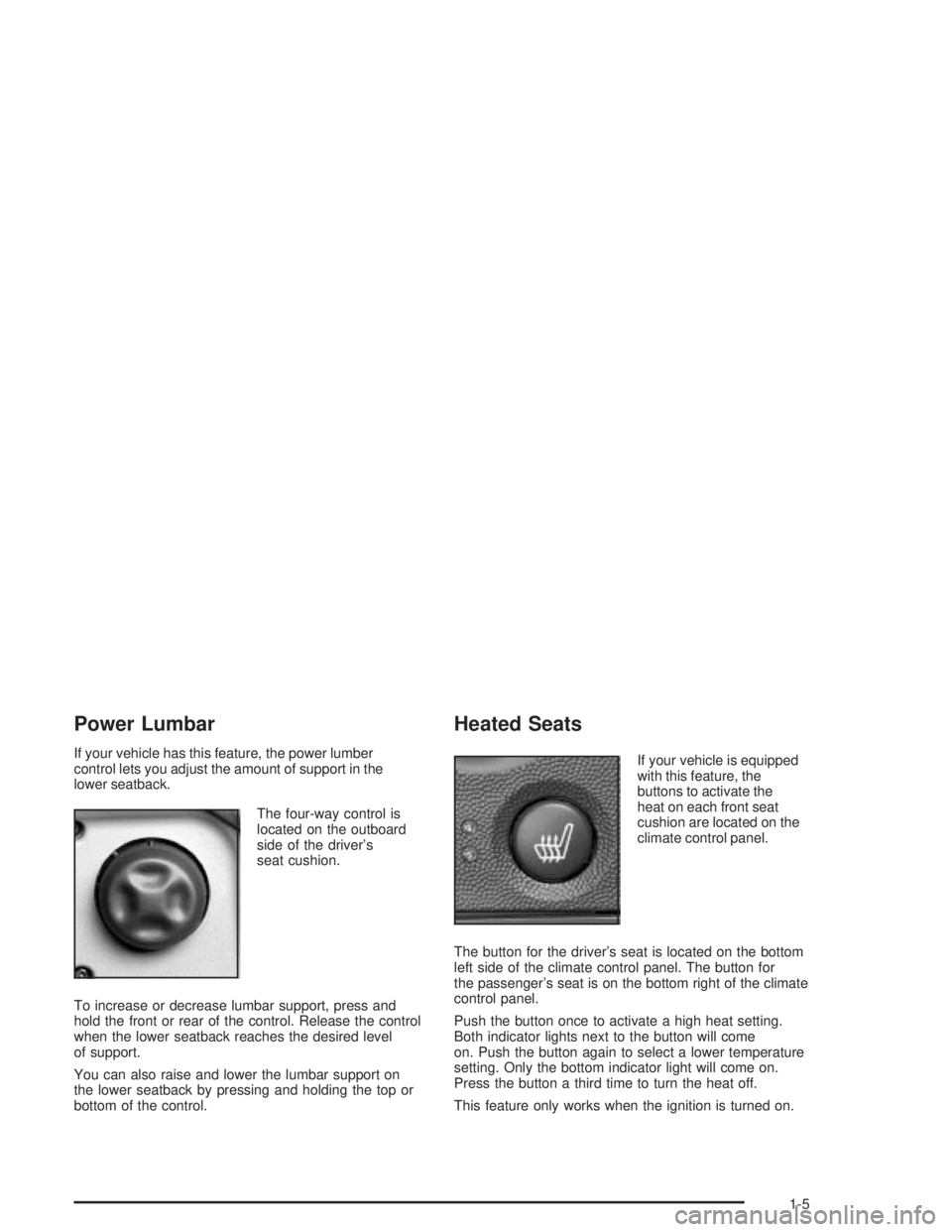
Power Lumbar
If your vehicle has this feature, the power lumber
control lets you adjust the amount of support in the
lower seatback.
The four-way control is
located on the outboard
side of the driver's
seat cushion.
To increase or decrease lumbar support, press and
hold the front or rear of the control. Release the control
when the lower seatback reaches the desired level
of support.
You can also raise and lower the lumbar support on
the lower seatback by pressing and holding the top or
bottom of the control.
Heated Seats
If your vehicle is equipped
with this feature, the
buttons to activate the
heat on each front seat
cushion are located on the
climate control panel.
The button for the driver's seat is located on the bottom
left side of the climate control panel. The button for
the passenger's seat is on the bottom right of the climate
control panel.
Push the button once to activate a high heat setting.
Both indicator lights next to the button will come
on. Push the button again to select a lower temperature
setting. Only the bottom indicator light will come on.
Press the button a third time to turn the heat off.
This feature only works when the ignition is turned on.
1-5
Page 12 of 432
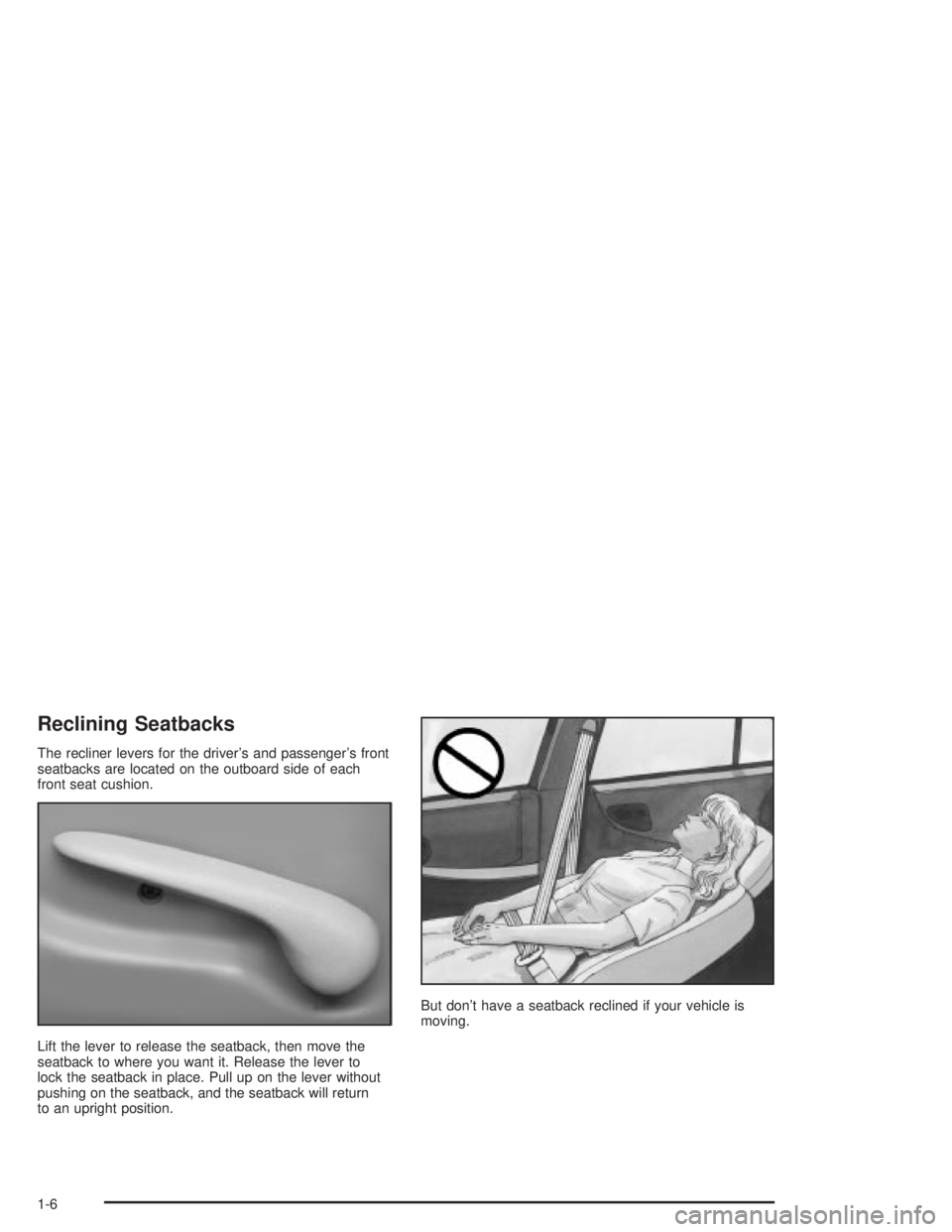
Reclining Seatbacks
The recliner levers for the driver's and passenger's front
seatbacks are located on the outboard side of each
front seat cushion.
Lift the lever to release the seatback, then move the
seatback to where you want it. Release the lever to
lock the seatback in place. Pull up on the lever without
pushing on the seatback, and the seatback will return
to an upright position.But don't have a seatback reclined if your vehicle is
moving.
1-6
Page 13 of 432
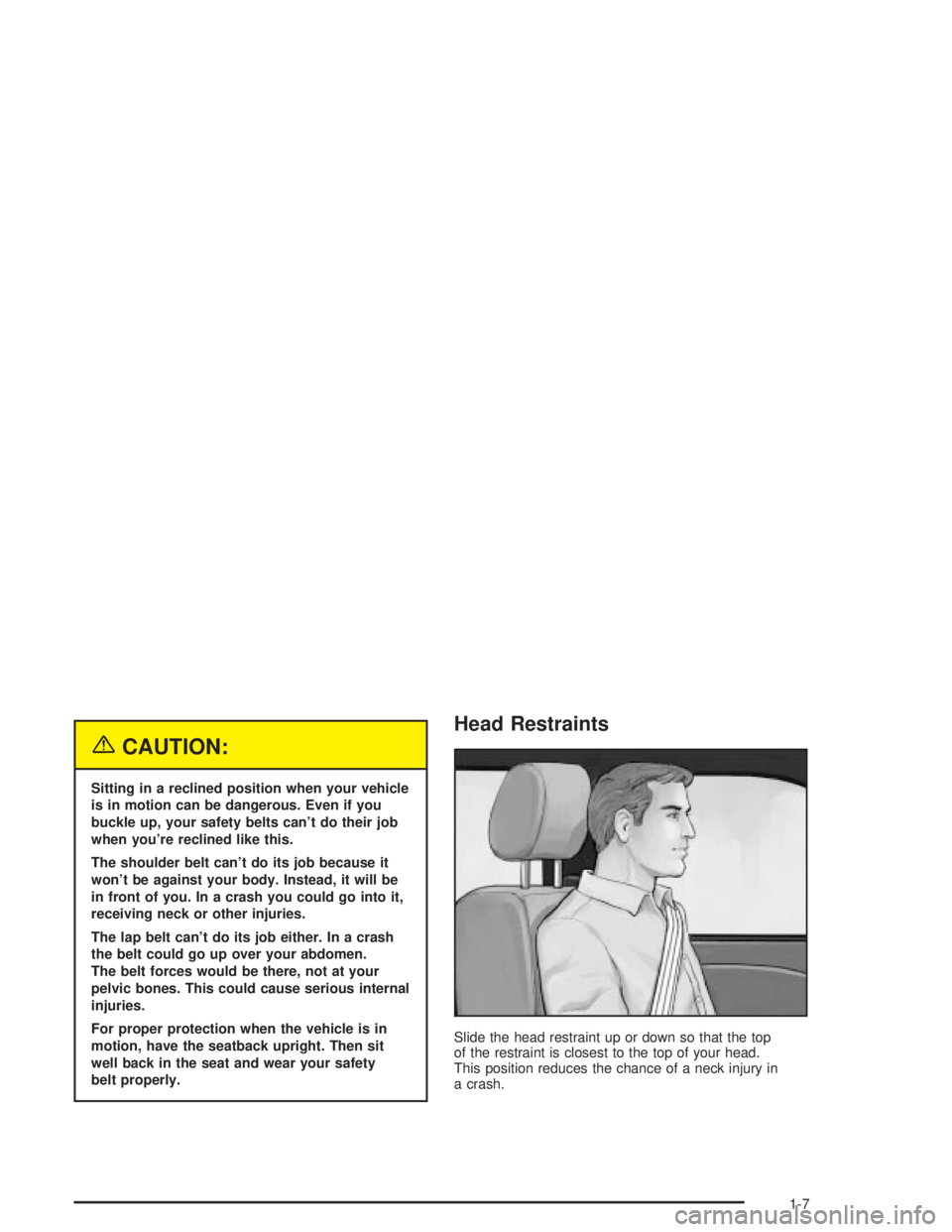
{CAUTION:
Sitting in a reclined position when your vehicle
is in motion can be dangerous. Even if you
buckle up, your safety belts can't do their job
when you're reclined like this.
The shoulder belt can't do its job because it
won't be against your body. Instead, it will be
in front of you. In a crash you could go into it,
receiving neck or other injuries.
The lap belt can't do its job either. In a crash
the belt could go up over your abdomen.
The belt forces would be there, not at your
pelvic bones. This could cause serious internal
injuries.
For proper protection when the vehicle is in
motion, have the seatback upright. Then sit
well back in the seat and wear your safety
belt properly.
Head Restraints
Slide the head restraint up or down so that the top
of the restraint is closest to the top of your head.
This position reduces the chance of a neck injury in
a crash.
1-7
Page 14 of 432
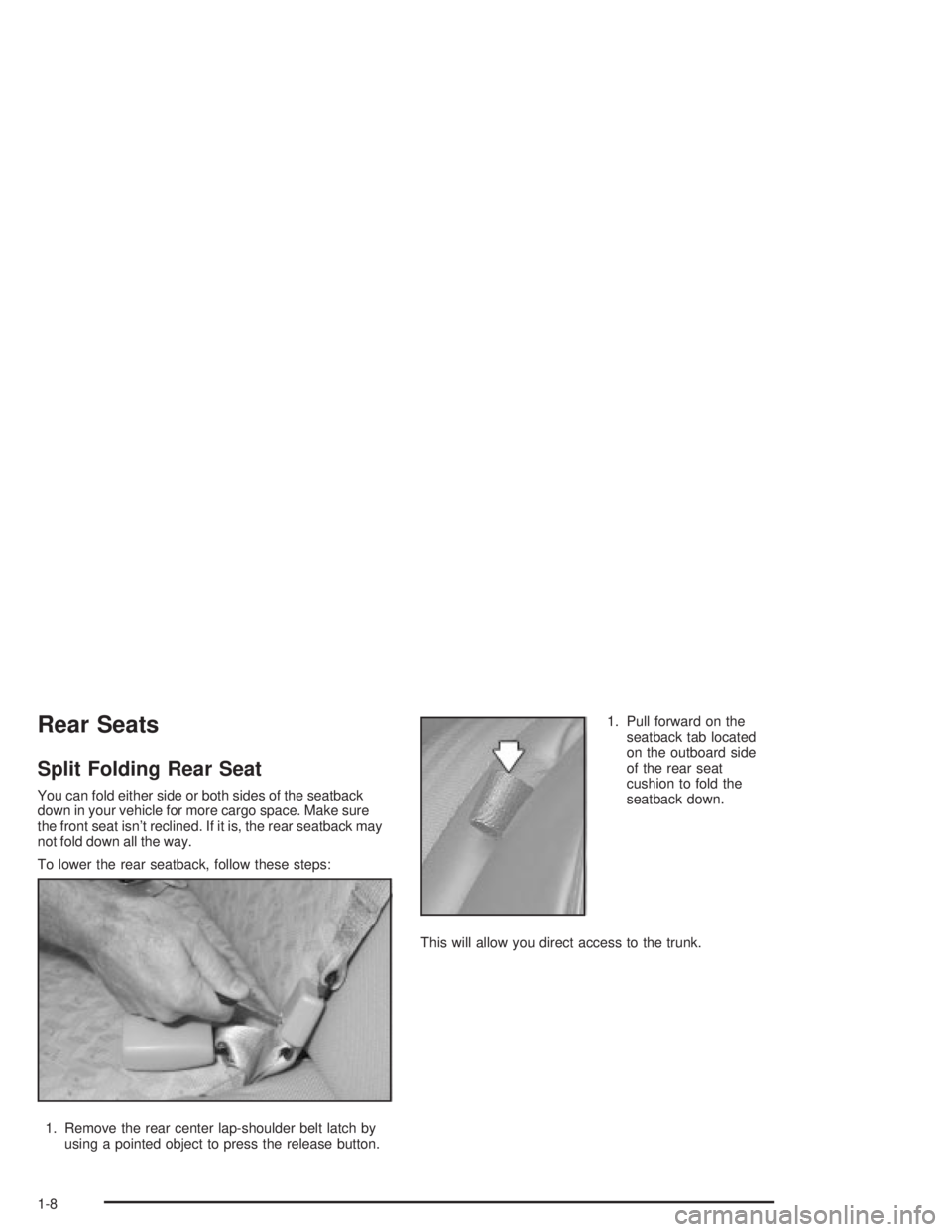
Rear Seats
Split Folding Rear Seat
You can fold either side or both sides of the seatback
down in your vehicle for more cargo space. Make sure
the front seat isn't reclined. If it is, the rear seatback may
not fold down all the way.
To lower the rear seatback, follow these steps:
1. Remove the rear center lap-shoulder belt latch by
using a pointed object to press the release button.1. Pull forward on the
seatback tab located
on the outboard side
of the rear seat
cushion to fold the
seatback down.
This will allow you direct access to the trunk.
1-8
Page 15 of 432
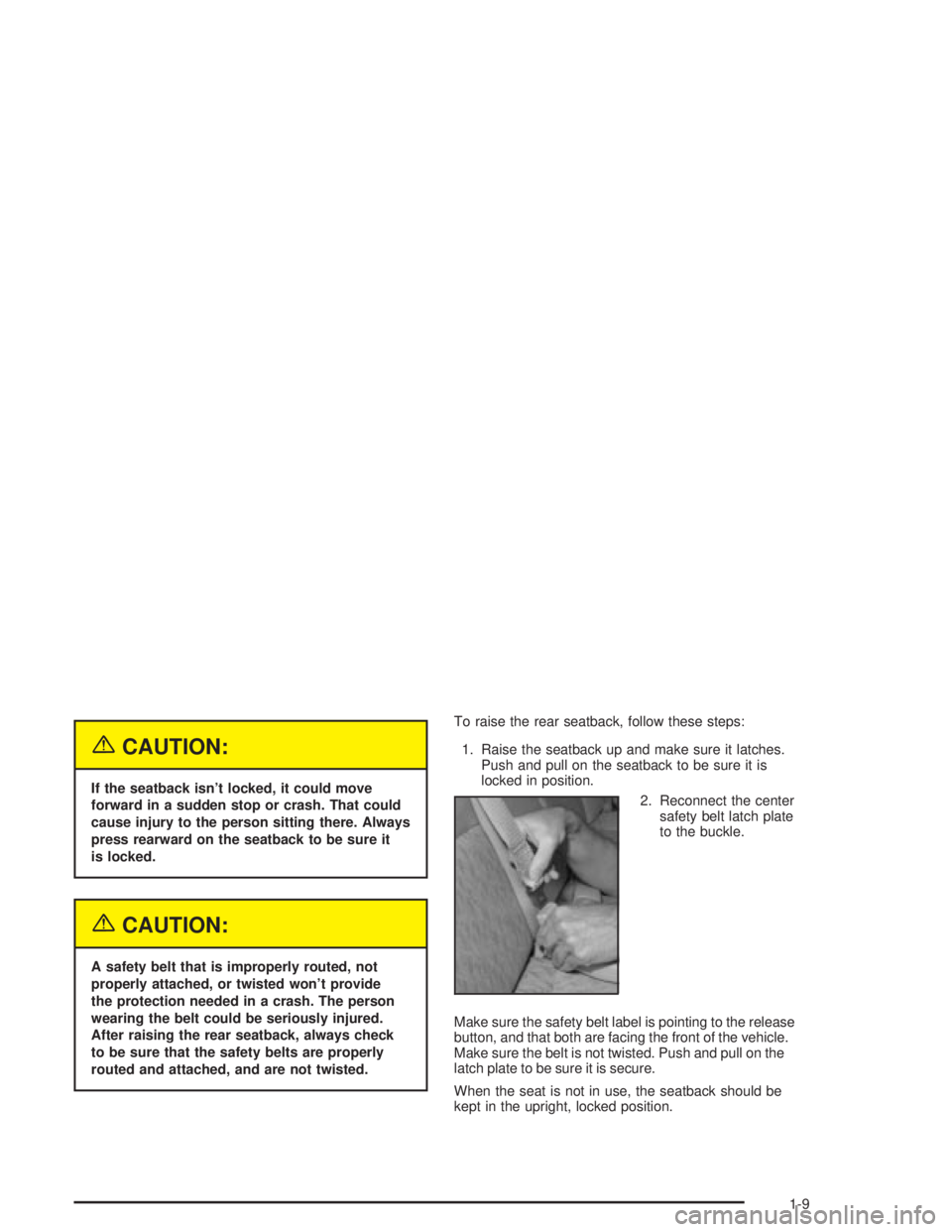
{CAUTION:
If the seatback isn't locked, it could move
forward in a sudden stop or crash. That could
cause injury to the person sitting there. Always
press rearward on the seatback to be sure it
is locked.
{CAUTION:
A safety belt that is improperly routed, not
properly attached, or twisted won't provide
the protection needed in a crash. The person
wearing the belt could be seriously injured.
After raising the rear seatback, always check
to be sure that the safety belts are properly
routed and attached, and are not twisted.To raise the rear seatback, follow these steps:
1. Raise the seatback up and make sure it latches.
Push and pull on the seatback to be sure it is
locked in position.
2. Reconnect the center
safety belt latch plate
to the buckle.
Make sure the safety belt label is pointing to the release
button, and that both are facing the front of the vehicle.
Make sure the belt is not twisted. Push and pull on the
latch plate to be sure it is secure.
When the seat is not in use, the seatback should be
kept in the upright, locked position.
1-9
Page 16 of 432
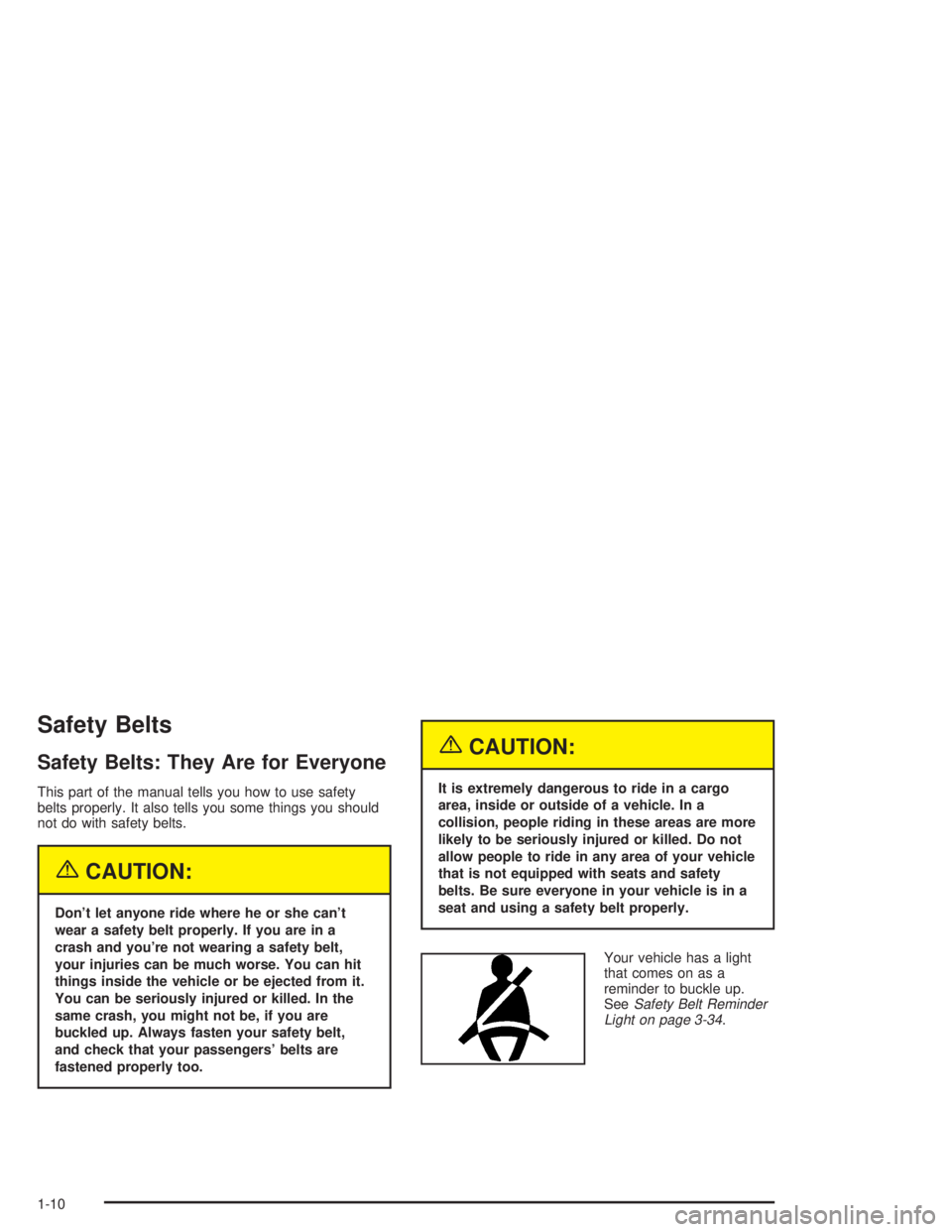
Safety Belts
Safety Belts: They Are for Everyone
This part of the manual tells you how to use safety
belts properly. It also tells you some things you should
not do with safety belts.
{CAUTION:
Don't let anyone ride where he or she can't
wear a safety belt properly. If you are in a
crash and you're not wearing a safety belt,
your injuries can be much worse. You can hit
things inside the vehicle or be ejected from it.
You can be seriously injured or killed. In the
same crash, you might not be, if you are
buckled up. Always fasten your safety belt,
and check that your passengers' belts are
fastened properly too.
{CAUTION:
It is extremely dangerous to ride in a cargo
area, inside or outside of a vehicle. In a
collision, people riding in these areas are more
likely to be seriously injured or killed. Do not
allow people to ride in any area of your vehicle
that is not equipped with seats and safety
belts. Be sure everyone in your vehicle is in a
seat and using a safety belt properly.
Your vehicle has a light
that comes on as a
reminder to buckle up.
See
Safety Belt Reminder
Light on page 3-34.
1-10
Page 17 of 432
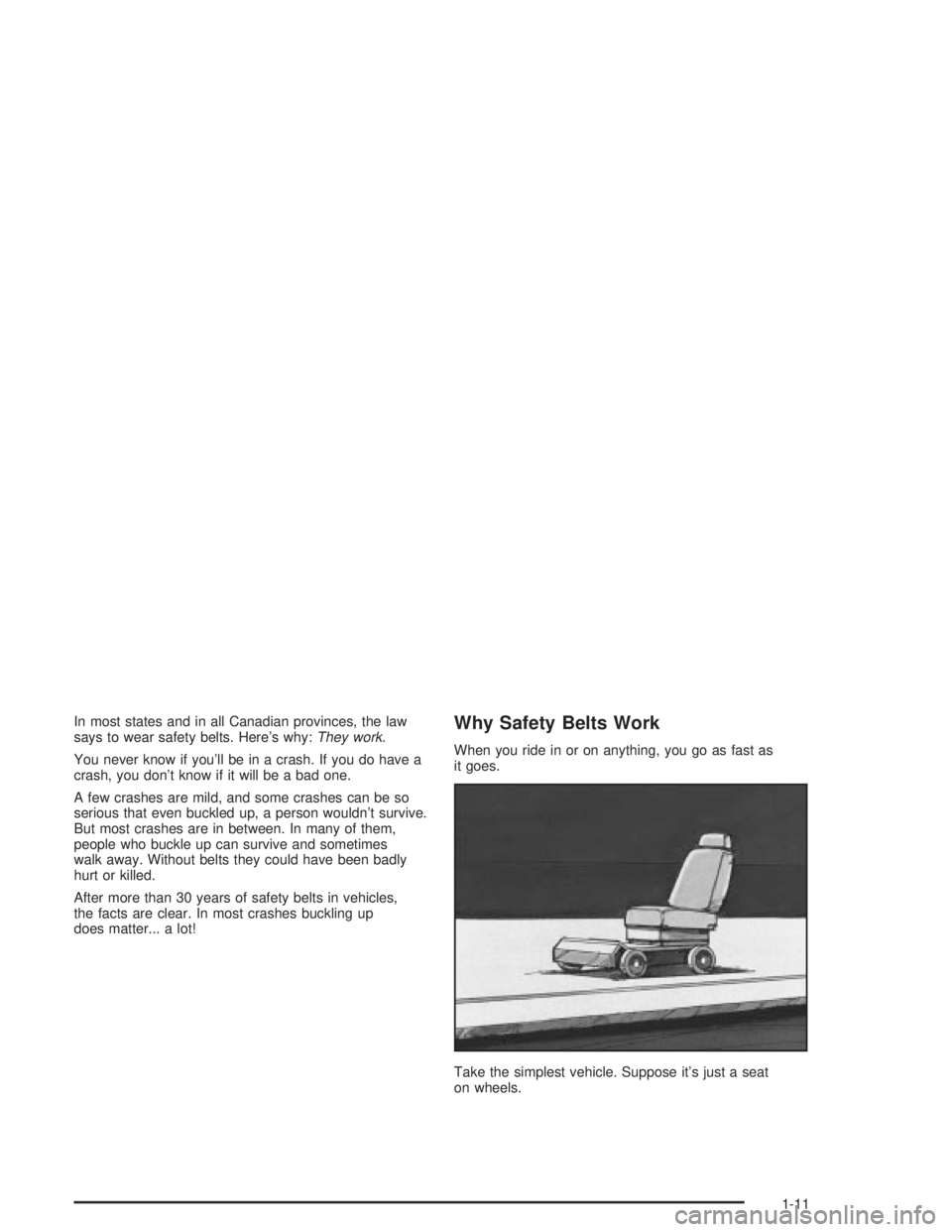
In most states and in all Canadian provinces, the law
says to wear safety belts. Here's why:They work.
You never know if you'll be in a crash. If you do have a
crash, you don't know if it will be a bad one.
A few crashes are mild, and some crashes can be so
serious that even buckled up, a person wouldn't survive.
But most crashes are in between. In many of them,
people who buckle up can survive and sometimes
walk away. Without belts they could have been badly
hurt or killed.
After more than 30 years of safety belts in vehicles,
the facts are clear. In most crashes buckling up
does matter... a lot!Why Safety Belts Work
When you ride in or on anything, you go as fast as
it goes.
Take the simplest vehicle. Suppose it's just a seat
on wheels.
1-11
Page 18 of 432
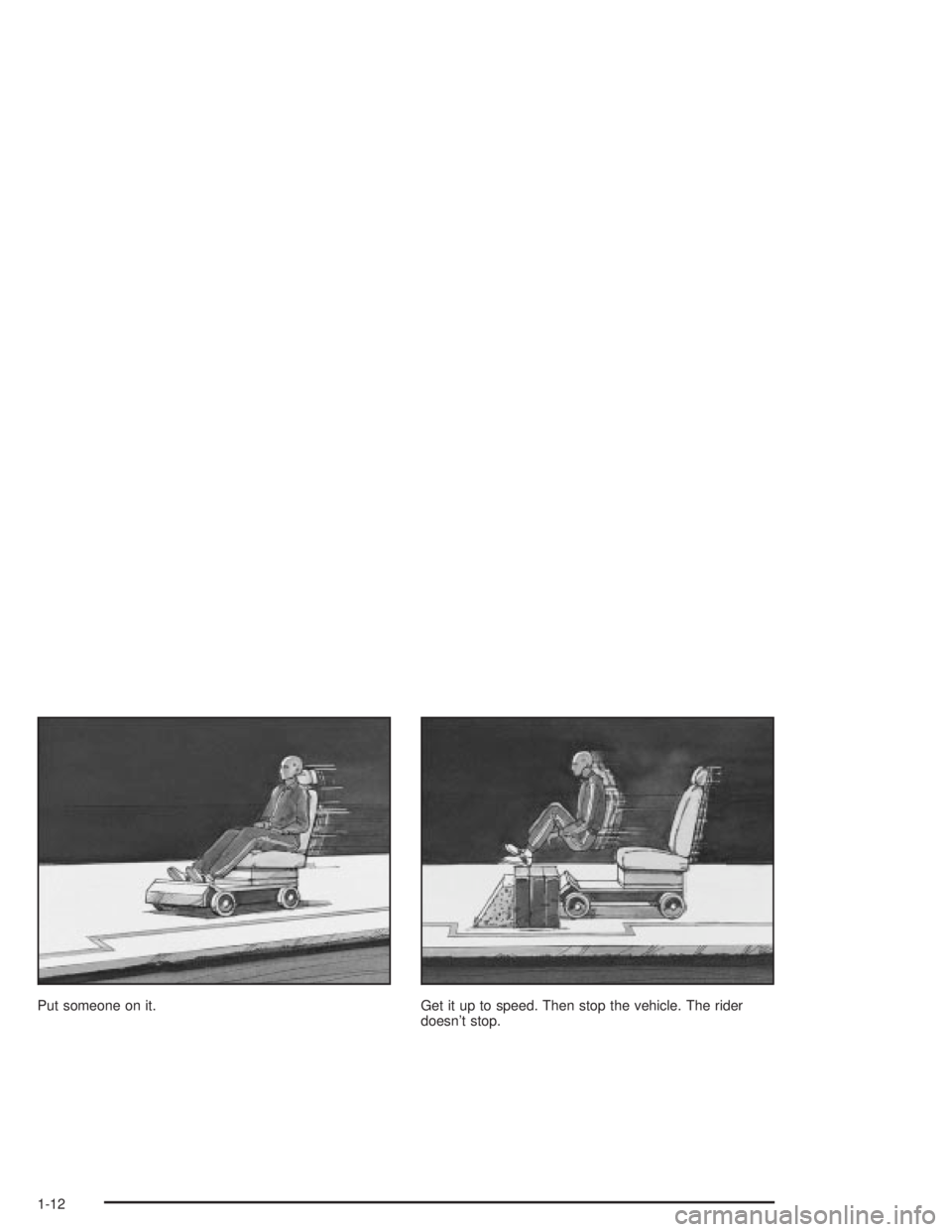
Put someone on it. Get it up to speed. Then stop the vehicle. The rider
doesn't stop.
1-12
Page 19 of 432
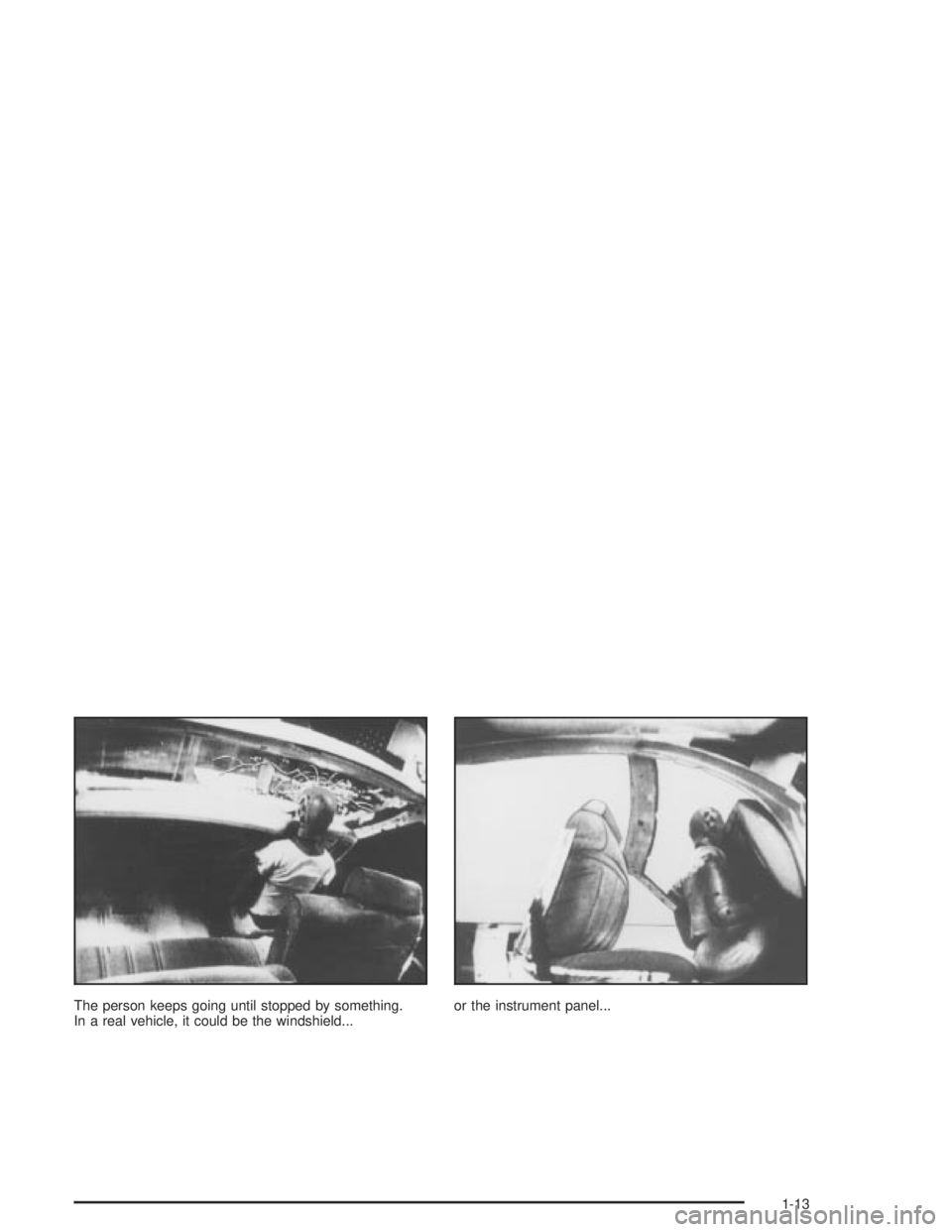
The person keeps going until stopped by something.
In a real vehicle, it could be the windshield...or the instrument panel...
1-13
Page 20 of 432
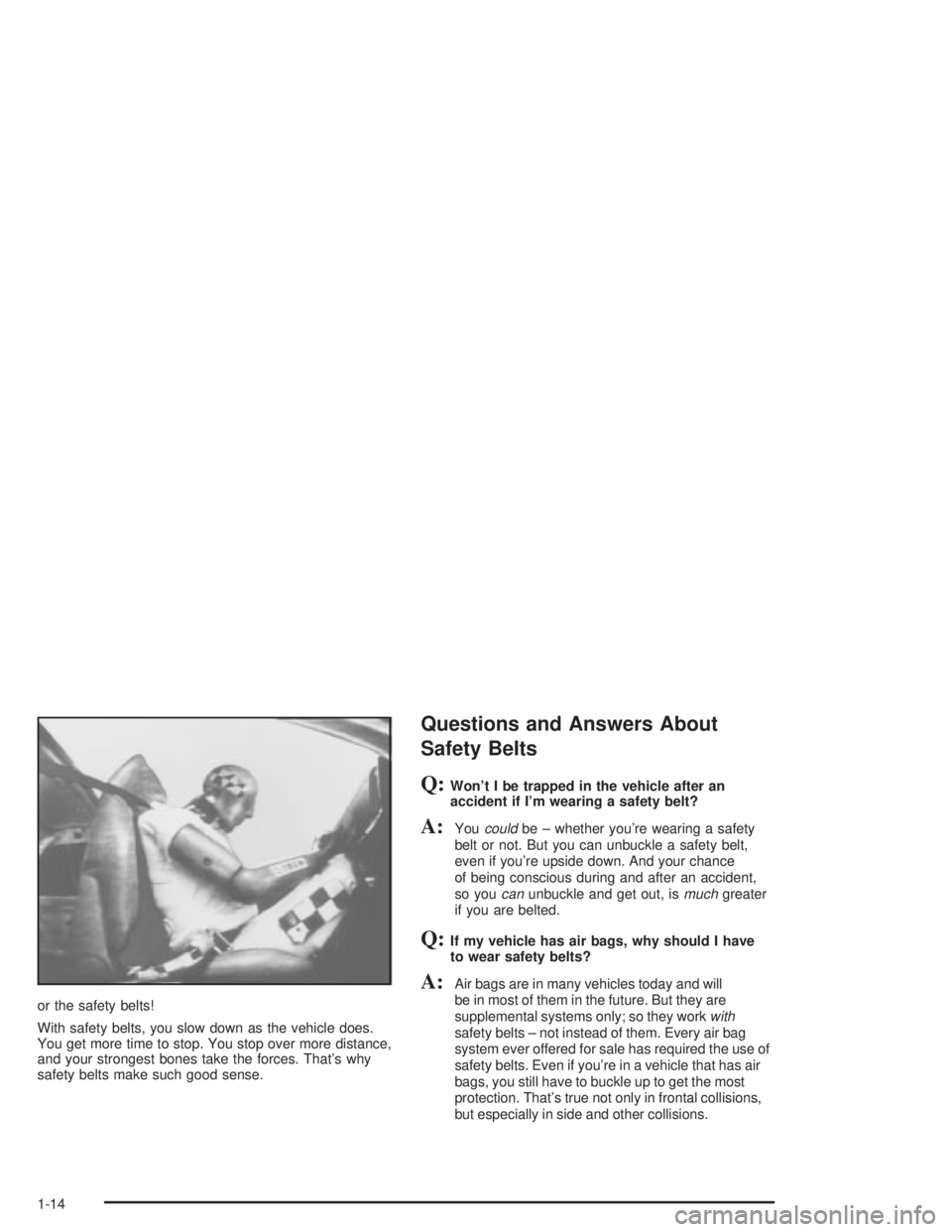
or the safety belts!
With safety belts, you slow down as the vehicle does.
You get more time to stop. You stop over more distance,
and your strongest bones take the forces. That's why
safety belts make such good sense.
Questions and Answers About
Safety Belts
Q:Won't I be trapped in the vehicle after an
accident if I'm wearing a safety belt?
A:Youcouldbe ± whether you're wearing a safety
belt or not. But you can unbuckle a safety belt,
even if you're upside down. And your chance
of being conscious during and after an accident,
so you
canunbuckle and get out, ismuchgreater
if you are belted.
Q:If my vehicle has air bags, why should I have
to wear safety belts?
A:Air bags are in many vehicles today and will
be in most of them in the future. But they are
supplemental systems only; so they work
with
safety belts ± not instead of them. Every air bag
system ever offered for sale has required the use of
safety belts. Even if you're in a vehicle that has air
bags, you still have to buckle up to get the most
protection. That's true not only in frontal collisions,
but especially in side and other collisions.
1-14